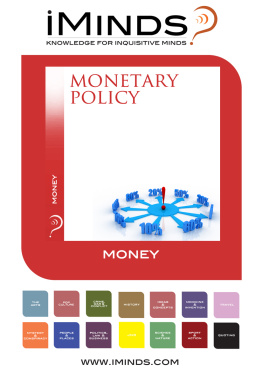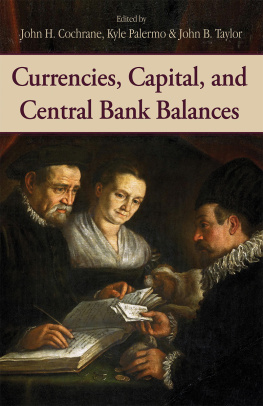Contents

Cover image: iStockphoto.com/trigga
Cover design: Wiley
Copyright 2014 by John Mauldin and Jonathan Tepper. All rights reserved.
Published by John Wiley & Sons, Inc., Hoboken, New Jersey.
Published simultaneously in Canada.
No part of this publication may be reproduced, stored in a retrieval system, or transmitted in any form or by any means, electronic, mechanical, photocopying, recording, scanning, or otherwise, except as permitted under Section 107 or 108 of the 1976 United States Copyright Act, without either the prior written permission of the Publisher, or authorization through payment of the appropriate per-copy fee to the Copyright Clearance Center, Inc., 222 Rosewood Drive, Danvers, MA 01923, (978) 750-8400, fax (978) 646-8600, or on the Web at www.copyright.com . Requests to the Publisher for permission should be addressed to the Permissions Department, John Wiley & Sons, Inc., 111 River Street, Hoboken, NJ 07030, (201) 748-6011, fax (201) 748-6008, or online at http://www.wiley.com/go/permissions .
Limit of Liability/Disclaimer of Warranty: While the publisher and author have used their best efforts in preparing this book, they make no representations or warranties with respect to the accuracy or completeness of the contents of this book and specifically disclaim any implied warranties of merchantability or fitness for a particular purpose. No warranty may be created or extended by sales representatives or written sales materials. The advice and strategies contained herein may not be suitable for your situation. You should consult with a professional where appropriate. Neither the publisher nor author shall be liable for any loss of profit or any other commercial damages, including but not limited to special, incidental, consequential, or other damages.
For general information on our other products and services or for technical support, please contact our Customer Care Department within the United States at (800) 762-2974, outside the United States at (317) 572-3993 or fax (317) 572-4002.
Wiley publishes in a variety of print and electronic formats and by print-on-demand. Some material included with standard print versions of this book may not be included in e-books or in print-on-demand. If this book refers to media such as a CD or DVD that is not included in the version you purchased, you may download this material at http://booksupport.wiley.com . For more information about Wiley products, visit www.wiley.com .
Library of Congress Cataloging-in-Publication Data:
Mauldin, John.
Code red : how to protect your savings from the coming crisis / John Mauldin and Jonathan Tepper.
pages cm
Includes bibliographical references and index.
ISBN 978-1-118-78372-6 (cloth)ISBN 978-1-118-78363-4 (ebk) ISBN 978-1-118-78373-3 (ebk)
1. MoneyUnited States. 2. Saving and investmentUnited States. 3. Currency crisesUnited States. 4. Financial crisesUnited States. I. Tepper, Jonathan, 1976- II. Title.
HG540.M38 2014
332.024dc23
2013035536
This book is dedicated to
our mothers.
Mildred Duke Mauldin (1917and still going)
No matter what life throws at her, she perseveres with grace
and a smile. One can grow up with no greater example of the
importance of showing up no matter what. She makes life better
for everyone who has ever known her.
Mary Prevatt Tepper (19452012)
She was a wonderful mother and a saint
who helped thousands of poor and needy
through Betel International.
This debilitating spiral has spurred our government to take massive action. In poker terms, the Treasury and the Fed have gone all in. Economic medicine that was previously meted out by the cupful has recently been dispensed by the barrel. These once-unthinkable dosages will almost certainly bring on unwelcome aftereffects. Their precise nature is anyones guess, though one likely consequence is an onslaught of inflation. Moreover, major industries have become dependent on Federal assistance, and they will be followed by cities and states bearing mind-boggling requests. Weaning these entities from the public teat will be a political challenge. They wont leave willingly.
Warren Buffett
Berkshire Hathaway 2008
Letter to Shareholders
Acknowledgments
We would gratefully like to acknowledge those who have helped us throughout the writing of this book. David Zervos provided the title of the book through his many humorous and insightful market commentaries. Our agent, Sam Hiyate at the Rights Factory, helped make this book happen. Our friends and reviewers of early drafts provided invaluable criticism. Charlie and Lisa Sweet of Mauldin Economics provided aggressive editing, which was needed. Evan Burton at Wiley helped bring this book to publication and into your hands.
Jonathan Tepper would like to thank his colleagues at Variant Perception, who provided many ideas and useful advice. Keir McGuinness and Jack Kirkland contributed their vast knowledge and deep insights to the chapter on commodities, gold, and real assets. Ziv Gil and Zvi Limon of Rimon Funds provided comments and criticisms and many interesting conversations and great times in Tel Aviv.
John Mauldin would like to thank his colleagues at Mauldin Economics for their support and insight, and especially Worth Wray. His business partner, Jon Sundt at Altegris Investments, has been patient. There are many people whose ideas have been foundational in my thinking but I would especially like to thank my friends Rob Arnott, Martin Barnes, Kyle Bass, Jim Bianco, Ian Brenner, Art Cashin, Bill Dunkelberg, Philippa Dunne, Albert Edwards, Mohammed El-Erian Niall Ferguson, George Friedman, Lewis and Charles Gave, Dylan Grice, Newt Gingrich, Richard Howard, Ben Hunt, Lacy Hunt, John Hussman, Niels Jensen, Anatole Kaletsky, Vitaly Katsenelson David Kotok, Michael Lewitt, Paul McCulley, Joan McCullough, Christian Menegatti, David McWilliams, Gary North, Barry Ritholtz, Nouriel Roubini, Tony Sagami, Kiron Sarkar, Gary Shilling, Dan Stelter, Grant Williams, Rich Yamarone, and scores of other writers and thinkers who have all been influential in my thinking.
Let me finally say that finishing this book would not have been possible before the end of the decade without the work and continual prodding of Jonathan Tepper. He is the best co-author any writer could have, especially one that is already overcommitted.
Any faults and omissions from the book, and we are sure there are many, are exclusively our own.
Introduction: Code Red
When Lehman Brothers went bankrupt and AIG was taken over by the U.S. government in the fall of 2008, the world almost came to an end. Over the next few weeks, stock markets went into free fall as trillions of dollars of wealth were wiped out. However, even more disturbing were the real-world effects on trade and businesses. A strange silence descended on the hubs of global commerce. As international trade froze, ships stood empty near ports around the world because banks would no longer issue letters of credit. Factories shut as millions of workers were laid off as commercial paper and money market funds used to pay wages froze. Major banks in the United States and the United Kingdom were literally hours away from shutting down and ATMs were on the verge of running out of cash. Bank stopped issuing letters of credit to former trusted partners worldwide. The interbank market simply froze, as no one knew who was bankrupt and who wasnt. Banks could look at their own balance sheets and see how bad things were and knew that their counterparties were also loaded up with too much bad debt.











